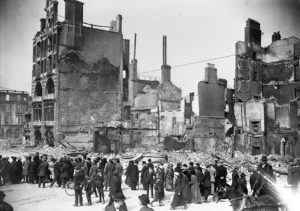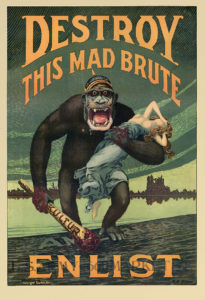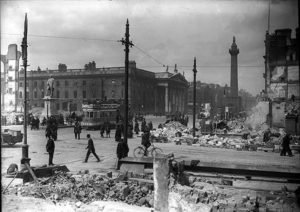“Kill them all. God will recognize his own.”- Arnaud Amaury, Abbott of Citeaux
Total war is referred to as such to distinguish it from limited war. Unlike in limited war, total war permits the usage of all resources a nation has at its disposal to destroy the enemy country; the goal is ultimately the complete destruction of the opposing force through whatever means necessary. The Home Front and the frontline are equally important to victory then. Yet this then allows for the targeting of civilians by combatants. In World War I the Germans subscribed to this ideology, using their long range artillery to deliberately attack civilian targets. In the 1916 Rising, the British authorities had to crush the rebellion quickly and viciously to keep the nations of the Commonwealth in check. Thus they waged a brief, total war against the Irish Volunteers.

To be truly total in its scope, a war must not only encompass the frontline but the home front as well. Any extended total war is a grueling affair, and World War I is one of the finest examples that history has ever presented. To keep the public on board, massive propaganda machines are often needed to counterbalance the casualty figures. These instruments of governmental policy generally served to dehumanize the enemy as much as possible to further prove the righteousness of the war effort.

One of the most controversial aspects of the doctrine of total war is that it allows and supports targeting of civilian populations. On the Western Front the clearest example of this was the German use of the Paris Gun. This behemoth had a 69 foot long barrel, and could launch a 234 lb. artillery shell 26 miles into the atmosphere, and hit a target up to 81 miles away (1). The mental toll would have been incredible, civilians were used to hearing stories of the horrors of artillery bombardments at the front. Now, they were truly in danger of having to live through them. Serving through the spring and summer of 1918, the Paris Gun launched over 300 shells into Paris, killing 250 and wounding over 620 more (2). Though its capabilities were limited, the psychological trauma was immense.
To violently and quickly crush the Rising in Dublin, the British authorities too had to revert to tenets of total war. In facing off against the Volunteers, the British soon realized that it was often difficult to tell who was really a non-combatant as most Volunteers had little in the way of uniform.
4. “Whilst fighting continued under conditions at once so confused and trying, it is possible that some innocent civilians were shot.(3)” – English general John Maxwell
At first glance, such an attitude may appear as being sorrowful. A soldier fighting against non-uniformed foes, out of fear and unsteady nerves may mistakenly shoot an innocent bystander. However the British military authorized the use of artillery within the city. And not only did that artillery target rebel positions, but it also cleared any building that stood in the line of fire. Thus buildings totally unoccupied by Volunteer forces were targeted and pulverized, leading inevitably to high casualties among the population of Dublin. Such use of total war tactics served to change popular opinions about England and the war effort.

In an era of photography, it was disdainful to send infantrymen into cities and shoot civilians (not to mention the obvious moral qualms of the infantrymen). Yet an artillery shell fired into a populated city center overrode these issues as it was all but completely impersonal. An artillery gunner firing from a mile, or 81 miles, away has little clue who he is potentially killing and thus can remove himself from at least some of the guilt. Therefore artillery units became the prime instruments of total war, as they offered the commanders the ability to target civilians while keeping their own troops in a semblance of moral upstanding.

- Military Factory, “21 cm/ 24cm Paris-Geschutz (Paris Gun)- Long Range, Super-Heavy Railway Gun (1918).”
- Ibid.
- 1916 Rebellion Handbook, N.p.: Irish Weekly Times, 1916, pgs. 101-102.
